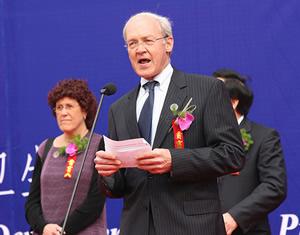
NIAID Deputy Director Hugh Auchincloss, M.D., addresses the audience at the opening of the first study of the Sino-U.S. (Henan) Tuberculosis Prevention and Treatment Research Institute.
Credit:
U.S. Embassy-China
Medicine and science have become international enterprises, far less constrained by national borders than at any other time in history. NIAID partners with foreign countries to address health challenges of global importance. The following are the types of agreements that govern these relationships:
- Bilateral agreements are country-to-country relationships established for the purpose of scientific cooperation. The relationships often are formalized through the development and signing of agreements and joint statements between the U.S. government and foreign governments. They typically focus on health and medical issues; involve scientific and technology agreements that foster biomedical research; and combine science, technology, and health into a single agreement. For example, NIAID serves as the Secretariat of the U.S.-Japan Cooperative Medical Sciences Program, which focuses on health issues affecting Southeast Asia.
- Trilateral agreements may involve NIAID and a second country interested in co-sponsoring research with a third country, usually in the developing world. For example, NIAID partners with the European and Developing Countries Clinical Trials Partnership to support the development of new interventions for malaria.

